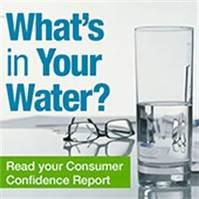
What is a Consumer Confidence Report?
A Consumer Confidence Report (CCR), which can be called an annual water quality report or a drinking water quality report, provides information on your local drinking water quality. Every community water supplier must provide an annual report by July 1 of each year to its customers, according to the U.S. Environmental Protection Agency’s (EPA) Consumer Confidence Report Rule.
A Guide to Understanding Your CCRA Consumer Confidence Report (CCR), which can be called an annual water quality report or a drinking water quality report, provides information on your local drinking water quality. Every community water supplier must provide an annual report by July 1 of each year to its customers, according to the U.S. Environmental Protection Agency’s (EPA) Consumer Confidence Report Rule. You may receive this by mail or electronically.
All CCRs must contain certain content elements. The specific information in your CCR is tailored to your local water system.
Keep in mind that while some things listed as "contaminants" in your CCR can be harmful to your health, others can be good for you, such as the appropriate amount of a disinfectant that keeps your water safe from germs. For more information on water quality and consumer confidence reports visit www.cdc.gov/healthywater.
LEAD IN DRINKING WATER
While most Wisconsin drinking water sources have little or no measurable lead, it is important to provide you with lead exposure information, found by clicking the button below.
Protecting your drinking water supply is also your responsibility!
What is a cross connection?
Cross Connection is a physical connection between a possible source of contamination and the public drinking water system piping. This connection, if not properly protected, can lead to the contamination of the drinking water system through a backflow event.
The most common example would be a section of garden hose connected to a faucet with the other end lying in area which could become covered with water from an undesirable source such as flood waters, sump pump water, or simply soapy water in a sink.
What is backflow?
Backflow is the reversal of water flow through a cross connection from a possible source of contamination into the public drinking water system. Backflow may be caused by either backpressure or backsiphonage. A loss of pressure in the public drinking water system may lead to backsiphonage through unprotected cross connections, or backpressure may be created when the water pressure of a facility’s internal water system is elevated above the supply pressure of the public drinking water system resulting in backflow through unprotected cross connections.
What can you do to prevent backflow situations in your home or business?
- Be aware of and eliminate and/or isolate cross connections.
- Maintain air gaps on sinks and when using hoses.
- Do not submerge hoses or place them where they could become submerged.
- Use hose bib vacuum breakers on fixtures (hose connections in the basement, laundry room, and on outside faucets/spigots).
- Do not create a connection between an auxiliary water system (well, cistern, body of water) and the water supply plumbing.
Why should you be concerned?
- Backflow may affect the quality of the drinking water at your residence or facility and has the potential to create health hazards if contaminated water enters your water supply plumbing system and is used for drinking, cooking or bathing.
- Backflow events occur more often than you might think although most do not create health hazards.
- Unprotected cross-connections with water supply plumbing or public drinking water piping systems are prohibited.
- You are responsible for protecting your water supply plumbing from backflow that may contaminate your drinking water and the drinking water of others. This includes complying with the plumbing code and not creating unprotected cross connections.
If you should have any questions about cross connection control please contact the City of Omro Water Utility.
By phone: (920) 685-7025
By fax: (920) 685-7028
